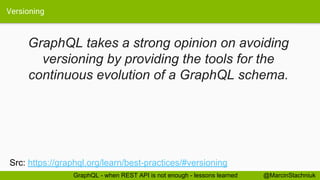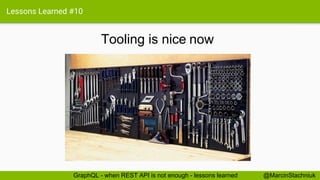GraphQL - when REST API is to less - lessons learned
- 1. GraphQL - when REST API is not enough - lessons learned Part 1 Marcin Stachniuk 8 October 2018
- 3. Agenda 11:00 ● Why? ● Concepts ● Basics 12:00 Lunch 13:00 ● GraphQL in Java ● Lessons learned @MarcinStachniukGraphQL - when REST API is not enough - lessons learned Monady w .NET – i tak używasz, więc dowiedz się, o co chodzi. Mateusz Stasch Rewolucja w analizie danych z RevoscaleR oraz RevoscalePy Tomasz Krawczyk Scale it the easy way - introduction to micro frontends Jakub Holak
- 4. Who is using REST? @MarcinStachniukGraphQL - when REST API is not enough - lessons learned
- 5. REST - REpresentational State Transfer https://api.example.com/customers/123 DELETE PUT POST GET PATCH @MarcinStachniukGraphQL - when REST API is not enough - lessons learned
- 6. REST fixed response GET /customers/111 { "customer": { "id": "111", "name": "John Doe", "email": "[email protected]", "company": { "id": "222" }, "orders": [ { "id": "333" }, { "id": "444" } ] } } { "customer": { "id": "111", "name": "John Doe", "email": "[email protected]", "company": { "href": "https://api.example.com/companies/222" }, "orders": [ { "href": "https://api.example.com/orders/333" }, { "href": "https://api.example.com/orders/444" } ] } } RE ST @MarcinStachniukGraphQL - when REST API is not enough - lessons learned
- 7. REST consequences: several roundtrips @MarcinStachniukGraphQL - when REST API is not enough - lessons learned U nderFetching
- 8. REST response with nested data GET /customers/111 { "customer": { "id": "111", "name": "John Doe", "email": "[email protected]", "company": { "id": "222", "name": "My Awesome Corporation", "website": "MyAwesomeCorporation.com" }, "orders": [ { "id": "333", "status": "delivered", "items": [ { "id": "555", "name": "Silver Bullet", "amount": "42", "price": "10000000", "currency": "USD", "producer": { "id": "777", "name": "Lorem Ipsum", "website": "LoremIpsum.com" } } ] }, { "id": "444", "name": "Golden Hammer", "amount": "5", "price": "10000", "currency": "USD", "producer": { ... } } ] } } RE ST @MarcinStachniukGraphQL - when REST API is not enough - lessons learned O verFetching
- 9. REST response with nested data and limit fields GET /customers/111?fields=name,company/*,orders.status,orders.items(name,producer/name) { "customer": { "id": "111", "name": "John Doe", "email": "[email protected]", "company": { "id": "222", "name": "My Awesome Corporation", "website": "MyAwesomeCorporation.com" }, "orders": [ { "id": "333", "status": "delivered", "items": [ { "id": "555", "name": "Silver Bullet", "amount": "42", "price": "10000000", "currency": "USD", "producer": { "id": "777", "name": "Lorem Ipsum", "website": "LoremIpsum.com" } } ] }, { "id": "444", "name": "Golden Hammer", "amount": "5", "price": "10000", "currency": "USD", "producer": { ... } } ] } } RE ST @MarcinStachniukGraphQL - when REST API is not enough - lessons learned
- 10. REST response with projection GET /customers/111?projection=customerPreview { "customer": { "id": "111", "name": "John Doe", "email": "[email protected]", "company": { "id": "222", "name": "My Awesome Corporation", "website": "MyAwesomeCorporation.com" }, "orders": [ { "id": "333", "status": "delivered", "items": [ { "id": "555", "name": "Silver Bullet", "amount": "42", "price": "10000000", "currency": "USD", "producer": { "id": "777", "name": "Lorem Ipsum", "website": "LoremIpsum.com" } } ] }, { "id": "444", "name": "Golden Hammer", "amount": "5", "price": "10000", "currency": "USD", "producer": { ... } } ] } } RE ST @MarcinStachniukGraphQL - when REST API is not enough - lessons learned
- 11. Different clients - different needs /web /iphone /android /tv Application Web iPhone Android TV RE ST @MarcinStachniukGraphQL - when REST API is not enough - lessons learned
- 12. Different clients - different needs /web /iphone /android /tv Application Web iPhone Android TV Content-Type: application/vnd.myawesomecorporation.com+v1+web+json iphone android tv RE ST @MarcinStachniukGraphQL - when REST API is not enough - lessons learned
- 13. Different clients - different needs /web /iphone /android /tv Application Web iPhone Android TV Content-Type: application/vnd.myawesomecorporation.com+v1+web+json iphone android tv RE ST @MarcinStachniukGraphQL - when REST API is not enough - lessons learned
- 14. REST contract is rigid @MarcinStachniukGraphQL - when REST API is not enough - lessons learned
- 15. Platform Architecture Platform App 1 App 2 Customer App X... @MarcinStachniukGraphQL - when REST API is not enough - lessons learned
- 16. REST API Versioning GET /v2/customers/111RE ST @MarcinStachniukGraphQL - when REST API is not enough - lessons learned GET /customers/111?v=v2RE ST GET /customers/111 Accept header: application/vnd.myapp.2+jsonRE ST GET /customers/111 Custom header: x-ms-version:2RE ST ● How to migrate? ● How to document? ● Is versionless API possible? ● What about continuous evolution of API?
- 17. Modularisation at UI @MarcinStachniukGraphQL - when REST API is not enough - lessons learned
- 18. New Frontend Framework ReactJS Relay GraphQL TypeScript @MarcinStachniukGraphQL - when REST API is not enough - lessons learned
- 19. GraphQL ● Graph Query Language ● Published by Facebook in 2015 ● Growth from Facebook Graph API ● Reference implementation in JavaScript @MarcinStachniukGraphQL - when REST API is not enough - lessons learned
- 20. GraphQL main concepts ● One endpoint for all operations ● Always define in request what you need ● Queries, Mutations and Subscriptions ● Defined by schema @MarcinStachniukGraphQL - when REST API is not enough - lessons learned
- 21. Data is a graph @MarcinStachniukGraphQL - when REST API is not enough - lessons learned
- 22. GraphQL time for demo ● Fragments ● Aliases ● Directives ● Interfaces ● Unions @MarcinStachniukGraphQL - when REST API is not enough - lessons learned ● Query ● Syntax Error ● Mutation ● Operation name ● Variables
- 23. GraphQL Simple API GET /customers/2?fields=id,name,email type Customer { #fields with ! are not null id: ID! name: String! email: String! } type Query { customer(id: String!): Customer! } { "data": { "customer": { "id": "2", "name": "name", "email": "[email protected]" } } } { customer(id: "2") { id name email } } RE ST @MarcinStachniukGraphQL - when REST API is not enough - lessons learned
- 24. GraphQL Bad Request GET /custo!@#$ -> 404 { "data": null, "errors": [ { "message": "Invalid Syntax", "locations": [ { "line": 2, "column": 8 } ], "errorType": "InvalidSyntax", "path": null, "extensions": null } ] } { custo!@#$ } RE ST http.cat/200 @MarcinStachniukGraphQL - when REST API is not enough - lessons learned
- 25. Go back to the roots @MarcinStachniukGraphQL - when REST API is not enough - lessons learned
- 26. GraphQL Simple API GET /customers/2?fields=id,name,email,company(id,name) type Customer { id: ID! name: String! email: String! company: Company } type Company { id: ID! name: String! website: String! } type Query { customer(id: String!): Customer! } { "data": { "customer": { "id": "2", "name": "name", "email": "[email protected]", "company": { "id": "211", "name": "Company Corp." } } } } { customer(id: "2") { id name email company { id name } } } RE ST @MarcinStachniukGraphQL - when REST API is not enough - lessons learned
- 27. GraphQL Simple API GET /customers/2?fields=id,name,email,orders(id,status) type Customer { id: ID! name: String! email: String! company: Company orders: [Order] } type Order { id: ID! status: Status } enum Status { NEW, CANCELED, DONE } { "data": { "customer": { "id": "2", "name": "name", "orders": [ { "id": "55", "status": "NEW" }, { "id": "66", "status": "DONE" } ] } } } { customer(id: "2") { id name orders { id status } } } RE ST @MarcinStachniukGraphQL - when REST API is not enough - lessons learned
- 28. GraphQL mutations input CreateCustomerInput { name: String email: String clientMutationId: String! } type CreateCustomerPayload { customer: Customer clientMutationId: String! } type Mutation { createCustomer(input: CreateCustomerInput): CreateCustomerPayload! } { "data": { "createCustomer": { "customer": { "id": "40", }, "clientMutationId": "123" } } } POST /customers PUT /customers/123 DELETE /customers/123 PATCH /customers/123 mutation { createCustomer(input: { name: "MyName" email: "[email protected]" clientMutationId: "123" }) { customer { id } clientMutationId } } RE ST @MarcinStachniukGraphQL - when REST API is not enough - lessons learned
- 29. GraphQL mutations + operation name mutation crCust { createCustomer(input: { name: "MyName" email: "[email protected]" clientMutationId: "123" }) { customer { id } clientMutationId } } { "data": { "createCustomer": { "customer": { "id": "40", }, "clientMutationId": "123" } } } POST /customers PUT /customers/123 DELETE /customers/123 PATCH /customers/123RE ST @MarcinStachniukGraphQL - when REST API is not enough - lessons learned mutation { createCustomer(input: { name: "MyName" email: "[email protected]" clientMutationId: "123" }) { customer { id } clientMutationId } }
- 30. GraphQL Variables { "data": { "createCustomer": { "customer": { "id": "40", }, "clientMutationId": "123" } } } POST /customers PUT /customers/123 DELETE /customers/123 PATCH /customers/123 mutation crCust { createCustomer(input: { name: "MyName" email: "[email protected]" clientMutationId: "123" }) { customer { id } clientMutationId } } RE ST @MarcinStachniukGraphQL - when REST API is not enough - lessons learned mutation crCust ($input: CreateCustInput) { createCustomer(input: $input) { customer { id } clientMutationId } } { "input": { "name": "MyName 2", "email": "[email protected]", "clientMutationId": "123" } }
- 31. GraphQL Aliases GET /customers/2?fields=id,name,email + { "data": { "cust1": { "id": "2", "name": "name", "email": "[email protected]" }, "cust2": { "id": "3", "name": "John Doe", "email": "[email protected]" } } } query get2Cust { cust1: customer(id: "2") { id name email } cust2: customer(id: "3") { id name email } } RE ST @MarcinStachniukGraphQL - when REST API is not enough - lessons learned GET /customers/3?fields=id,name,emailRE ST
- 32. GraphQL Fragment GET /customers/2?fields=id,name,email + { "data": { "cust1": { "id": "2", "name": "name", "email": "[email protected]" }, "cust2": { "id": "3", "name": "John Doe", "email": "[email protected]" } } } query get2Cust { cust1: customer(id: "2") { ... frag1 } cust2: customer(id: "3") { ... frag1 } } fragment frag1 on Customer { id name email } RE ST @MarcinStachniukGraphQL - when REST API is not enough - lessons learned GET /customers/3?fields=id,name,emailRE ST
- 33. GraphQL Directive GET /customers/2?fields=id,name { "data": { "customer": { "id": "2", "name": "name" } } } query getCust ($showEmail: Boolean!) { customer(id: "2") { id name email @include(if: $showEmail) } } { "showEmail": false } RE ST @MarcinStachniukGraphQL - when REST API is not enough - lessons learned
- 34. GraphQL Interface GET /users?fields=id,name,superAdmin,permissions type Query { users: [User] } interface User { id: ID! name: String! email: String! } type Admin implements User { superAdmin: Boolean! // + id... } type Moderator implements User { permissions: [String] // + id... } { "data": { "users": [ { "id": "777", "name": "Admin a", "superAdmin": true }, { "id": "888", "name": "Moderator", "permissions": [ "Delete Customer", "Delete comment" ]}]}} query getUsers { users { ... on Admin { id name superAdmin } ... on Moderator { id name permissions } } } RE ST @MarcinStachniukGraphQL - when REST API is not enough - lessons learned
- 35. GraphQL Union GET /search?input=a?fields=typename,name type Query { search(input: String): [SearchResult] } union SearchResult = Customer | Admin | Moderator { "data": { "search": [ { "__typename": "Customer", "name": "name" }, { "__typename": "Admin", "name": "Admin a" }, { "__typename": "Moderator", "name": "Moderator" }]}} query searchSmth { search(input: "a") { __typename ... on Customer { name } ... on Admin { name } ... on Moderator { name } } } RE ST @MarcinStachniukGraphQL - when REST API is not enough - lessons learned
- 36. Q&A @MarcinStachniukGraphQL - when REST API is not enough - lessons learned
- 37. Feedback @MarcinStachniukGraphQL - when REST API is not enough - lessons learned
- 38. To be continued... @MarcinStachniukGraphQL - when REST API is not enough - lessons learned
- 39. GraphQL - when REST API is not enough - lessons learned Part 2 Marcin Stachniuk 8 October 2018
- 40. Agenda 11:00 ● Why? ● Concepts ● Basics 12:00 Lunch 13:00 ● GraphQL in Java ● Lessons learned @MarcinStachniukGraphQL - when REST API is not enough - lessons learned Serverless .NET on AWS Wojciech Gawroński Lunch
- 41. GraphQL ● Graph Query Language ● Published by Facebook in 2015 ● Growth from Facebook Graph API ● Reference implementation in JavaScript ● First version of Java Library: 18 Jul 2015 https://github.com/graphql-java/graphql-java ● First usage: 21 Sep 2015 @MarcinStachniukGraphQL - when REST API is not enough - lessons learned
- 42. Lessons Learned #1 Never add a library to your project few days after init release @MarcinStachniukGraphQL - when REST API is not enough - lessons learned ● No community ● A lot of bugs ● Bad documentation ● Strict following reference implementation and specification DO NOT TRY THIS AT WORK
- 43. GraphQL Simple API GET /customers/2?fields=id,name,email,orders(id,status) type Customer { id: ID! name: String! email: String! company: Company orders: [Order] } type Order { id: ID! status: Status } enum Status { NEW, CANCELED, DONE } { "data": { "customer": { "id": "2", "name": "name", "orders": [ { "id": "55", "status": "NEW" }, { "id": "66", "status": "DONE" } ] } } } { customer(id: "2") { id name orders { id status } } } RE ST @MarcinStachniukGraphQL - when REST API is not enough - lessons learned
- 44. How to implement DataFetcher for queries GET /customers/2?fields=id,name,email,orders(id,status) @Component public class CustomerFetcher extends PropertyDataFetcher<Customer> { @Autowired private CustomerService customerService; @Override public Customer get(DataFetchingEnvironment environment) { String id = environment.getArgument("id"); return customerService.getCustomerById(id); } } RE ST { customer(id: "2") { id name orders { id status } } } @MarcinStachniukGraphQL - when REST API is not enough - lessons learned
- 45. How to implement DataFetcher for queries GET /customers/2?fields=id,name,email,orders(id,status) public class Customer { private String id; private String name; private String email; // getters are not required } RE ST { customer(id: "2") { id name orders { id status } } } @MarcinStachniukGraphQL - when REST API is not enough - lessons learned public class OrderDataFetcher extends PropertyDataFetcher<List<Order>> { @Override public List<Order> get(DataFetchingEnvironment environment) { Customer source = environment.getSource(); String customerId = source.getId(); return orderService.getOrdersByCustomerId(customerId); } }
- 46. GraphQL mutations input CreateCustomerInput { name: String email: String clientMutationId: String! } type CreateCustomerPayload { customer: Customer clientMutationId: String! } type Mutation { createCustomer(input: CreateCustomerInput): CreateCustomerPayload! } { "data": { "createCustomer": { "customer": { "id": "40", }, "clientMutationId": "123" } } } POST /customers PUT /customers/123 DELETE /customers/123 PATCH /customers/123 mutation { createCustomer(input: { name: "MyName" email: "[email protected]" clientMutationId: "123" }) { customer { id } clientMutationId } } RE ST @MarcinStachniukGraphQL - when REST API is not enough - lessons learned
- 47. How to implement DataFetcher for mutations POST /customers PUT /customers/123 DELETE /customers/123 PATCH /customers/123 @Component public class CreateCustomersFetcher extends PropertyDataFetcher<CreateCustomersPayload> { @Override public CreateCustomerPayload get(DataFetchingEnvironment env) { Map<String, Object> input = env.getArgument("input"); String name = (String) input.get("name"); String email = (String) input.get("email"); String clientMutationId = (String) input.get("clientMutationId"); Customer customer = customerService.create(name, email); return new CreateCustomerPayload(customer, clientMutationId); } RE ST mutation { createCustomer(input: { name: "MyName" email: "[email protected]" clientMutationId: "123" }) { customer { id } clientMutationId } } @MarcinStachniukGraphQL - when REST API is not enough - lessons learned
- 48. In case Interfaces and Unions - Type Resolver is needed public class UserTypeResolver implements TypeResolver { @Override public GraphQLObjectType getType(TypeResolutionEnvironment env) { Object javaObject = env.getObject(); if (javaObject instanceof Admin) { return env.getSchema().getObjectType("Admin"); } else if (javaObject instanceof Moderator) { return env.getSchema().getObjectType("Moderator"); } else { throw new RuntimeException("Unknown type " + javaObject.getClass().getName()); } } } public interface User {...} public class Admin implements User {...} public class Moderator implements User {...} @MarcinStachniukGraphQL - when REST API is not enough - lessons learned
- 49. Glue everything together RuntimeWiring runtimeWiring = RuntimeWiring.newRuntimeWiring() .type("Query", builder -> builder.dataFetcher("customer", customerFetcher)) .type("Mutation", builder -> builder.dataFetcher("createCustomer", createCustomerFetcher)) .type(newTypeWiring("User") .typeResolver(new UserTypeResolver()) .build()) ... .build(); @MarcinStachniukGraphQL - when REST API is not enough - lessons learned
- 50. Abstraction over GraphQL Java Our abstraction Data Fetcher 2 Inputs mapping to objects Schema definition Pagination ... Data Fetcher 1 Data Fetcher N... @MarcinStachniukGraphQL - when REST API is not enough - lessons learned
- 51. Lessons Learned #2 Abstraction is not good if you don’t understand how it works under the hood @MarcinStachniukGraphQL - when REST API is not enough - lessons learned ● Copy paste errors ● Wrong usage ● Hard to update to new version
- 52. GraphQL type system How to define your schema? @MarcinStachniukGraphQL - when REST API is not enough - lessons learned
- 53. Code First approach private GraphQLFieldDefinition customerDefinition() { return GraphQLFieldDefinition.newFieldDefinition() .name("customer") .argument(GraphQLArgument.newArgument() .name("id") .type(new GraphQLNonNull(GraphQLString))) .type(new GraphQLNonNull(GraphQLObjectType.newObject() .name("Customer") .field(GraphQLFieldDefinition.newFieldDefinition() .name("id") .description("fields with ! are not null") .type(new GraphQLNonNull(GraphQLID)) .build()) …. .build())) .dataFetcher(customerFetcher) .build(); } Schema First approach type Query { customer(id: String!): Customer! } type Customer { #fields with ! are not null id: ID! name: String! email: String! company: Company orders: [Order] } @MarcinStachniukGraphQL - when REST API is not enough - lessons learned
- 54. Code First approach - How to build Introspection query Introspection response Replace Relay definitions @MarcinStachniukGraphQL - when REST API is not enough - lessons learned Typescript relay plugin
- 55. Schema First approach type Customer { # fields with ! are required id: ID! name: String! email: String! company: Company orders: [Order] } *.graphqls SchemaParser schemaParser = new SchemaParser(); File file = // ... TypeDefinitionRegistry registry = schemaParser.parse(file); SchemaGenerator schemaGenerator = new SchemaGenerator(); RuntimeWiring runtimeWiring = RuntimeWiring.newRuntimeWiring() .type("Query", builder -> builder.dataFetcher("customer", customerFetcher)) // ... .build(); return schemaGenerator.makeExecutableSchema(registry, runtimeWiring); @MarcinStachniukGraphQL - when REST API is not enough - lessons learned
- 56. Schema First approach - project building diagram model.graphqls @MarcinStachniukGraphQL - when REST API is not enough - lessons learned
- 57. GraphQL SPQR @MarcinStachniukGraphQL - when REST API is not enough - lessons learned https://github.com/leangen/graphql-spqr SPQR - Senatus Populusque Romanus
- 58. SPQR approach public class UserService { @GraphQLQuery(name = "user") public User getById(@GraphQLArgument(name = "id") Integer id) { //... } } public class Customer { //... @GraphQLQuery(name = "name", description = "A person's name") public String getName() { return name; } } @MarcinStachniukGraphQL - when REST API is not enough - lessons learned
- 59. Lessons Learned #3 Code First Approach is the worst Schema First Approach: ● Easy to maintain and understand ● Helps organise work ● Demo schema is 3x smaller GraphQL SPQR - ? Code First approach: ● Hard to maintain ● It was the only way at the beginning to define a schema ● No possibility to mix both ● No easy way to migrate to Schema First @MarcinStachniukGraphQL - when REST API is not enough - lessons learned
- 60. From Code First to Schema First migration https://github.com/mstachniuk/graphql-schema-from-introspection-generator @MarcinStachniukGraphQL - when REST API is not enough - lessons learned
- 61. GraphQL - How to define pagination, filtering, sorting? Pagination: ● before, after ● offset, limit Filtering: ● filter(name: “Bob” email: “%@gmail.com”) ● filter: { OR: [{ email: “%@gmail.com” }] }, name: “Bob” } Sorting: ● orderBy: ASC, DESC ● sort: NEWEST, IMPORTANCE @MarcinStachniukGraphQL - when REST API is not enough - lessons learned
- 62. Lessons Learned #4 GraphQL is not full query language @MarcinStachniukGraphQL - when REST API is not enough - lessons learned ● Flexibility ● Less common conventions ● Dgraph.io created GraphQL+-
- 63. GraphQL downsides @MarcinStachniukGraphQL - when REST API is not enough - lessons learned
- 64. GraphQL downsides: N+1 problem { customers { 1 call id name orders { n calls id status } } } java-dataloader ● Add async BatchLoader ● Add caching @MarcinStachniukGraphQL - when REST API is not enough - lessons learned graphQL = GraphQL.newGraphQL(schema) .queryExecutionStrategy( new BatchedExecutionStrategy()) .build(); + @Batched in DataFetcher#get()
- 65. Lessons Learned #5 If you have N + 1 problem use java-dataloader @MarcinStachniukGraphQL - when REST API is not enough - lessons learned
- 66. Complex Queries fragment TypeRef on __Type { kind name ofType { kind name ofType { kind name ... } } } @MarcinStachniukGraphQL - when REST API is not enough - lessons learned graphQL = GraphQL.newGraphQL(schema) .instrumentation( new ChainedInstrumentation(asList( new MaxQueryComplexityInstrumentation(200), new MaxQueryDepthInstrumentation(20) ))) .build();
- 67. Lessons Learned #6 Performance killer? Define instrumentation! @MarcinStachniukGraphQL - when REST API is not enough - lessons learned
- 68. GraphQL downsides: Bad GraphQL API definition - examples { customer(id: "2") { … } customerFull(id: "2") { … } customerFull2(id: "2") { … } customerWithDetails(id: "2") { … } ... } @MarcinStachniukGraphQL - when REST API is not enough - lessons learned { customer(id: "2") { id name orders { id status } } }
- 69. GraphQL downsides: Bad GraphQL API definition - examples query getUser { user(id: "123") { ... on Admin { id superAdmin } ... on Moderator { id permissions } } } { admin(id: "123") { id superAdmin } moderator(id: "123") { id permissions } } @MarcinStachniukGraphQL - when REST API is not enough - lessons learned
- 70. GraphQL downsides: Bad GraphQL API definition - examples { orders (input: { status: "NEW" first: "2" offset: "3" }, first: "1", offset: "3") { Items { … } } @MarcinStachniukGraphQL - when REST API is not enough - lessons learned
- 71. Lessons Learned #7 Thinking shift is a key @MarcinStachniukGraphQL - when REST API is not enough - lessons learned ● Let’s think in graphs and NOT in endpoints / resources / entities / DTOs ● Bad design of our API
- 72. GraphQL Testing @MarcinStachniukGraphQL - when REST API is not enough - lessons learned
- 73. Testing GraphQL @SpringBootTest @ContextConfiguration(classes = Main) class CustomerFetcherSpec extends Specification { @Autowired GraphQLSchema graphQLSchema GraphQL graphQL def setup() { graphQL = GraphQL.newGraphQL(graphQLSchema).build() } @MarcinStachniukGraphQL - when REST API is not enough - lessons learned
- 74. Testing GraphQL def "should get customer by id"() { given: def query = """{ customer(id: "2") { … } }""" def expected = [ "customer": [ … ] ] when: def result = graphQL.execute(query) then: result.data == expected } @MarcinStachniukGraphQL - when REST API is not enough - lessons learned
- 75. Lessons Learned #8 Testing is easy @MarcinStachniukGraphQL - when REST API is not enough - lessons learned Trap Adventure 2 - "The Hardest Retro Game"
- 76. Versioning @MarcinStachniukGraphQL - when REST API is not enough - lessons learned GraphQL takes a strong opinion on avoiding versioning by providing the tools for the continuous evolution of a GraphQL schema. Src: https://graphql.org/learn/best-practices/#versioning
- 77. Versioning type Query { customer(id: String!): Customer! @deprecated(reason: "not used ...") @MarcinStachniukGraphQL - when REST API is not enough - lessons learned
- 78. Lessons Learned #9 Versioning is not a problem @MarcinStachniukGraphQL - when REST API is not enough - lessons learned GET /v2/customers/111RE ST GET /customers/111?v=v2RE ST GET /customers/111 Accept header: application/vnd.myapp.2+jsonRE ST GET /customers/111 Custom header: x-ms-version:2RE ST Versioning problem is different
- 79. Tools @MarcinStachniukGraphQL - when REST API is not enough - lessons learned
- 80. Tools GraphiQL @MarcinStachniukGraphQL - when REST API is not enough - lessons learned
- 81. Tools Relay @MarcinStachniukGraphQL - when REST API is not enough - lessons learned @MarcinStachniukGraphQL - when REST API is not enough - lessons learned user(...) { photo(width: "120", height: "120") } user(...) { name } user(...) { email } user(...) { name email photo(width: "120", height: "120") }
- 82. Distelli/graphql-apigen https://github.com/Distelli/graphql-apigen Generate Java APIs with GraphQL Schemas in order to facilitate "schema first" development. @MarcinStachniukGraphQL - when REST API is not enough - lessons learned
- 83. GraphQL Java Tools https://github.com/graphql-java/graphql-java-tools Map GraphQL schema to POJOs @MarcinStachniukGraphQL - when REST API is not enough - lessons learned
- 84. More libraries and projects related to graphql-java https://github.com/graphql-java/awesome-graphql-java @MarcinStachniukGraphQL - when REST API is not enough - lessons learned ● Generates a GraphQL schema from a JDBC data source ● Annotations-based syntax for GraphQL schema definition ● JPA Implementation of GraphQL (builds on graphql-java) ● And more examples
- 85. Apollo @MarcinStachniukGraphQL - when REST API is not enough - lessons learned Build a universal GraphQL API on top of your existing REST APIs, so you can ship new application features fast without waiting on backend changes.
- 86. Lessons Learned #10 Tooling is nice @MarcinStachniukGraphQL - when REST API is not enough - lessons learned now
- 87. Summary GraphQL Pros: ● Nice alternative to REST ● It can be used together with REST ● Good integration with Relay / ReactJS ● You get exactly what you want to get ● Good for API with different clients ● Good to use on top of existing API ● Self documented ● Easy testing ● Nice tooling ● Thin layer GraphQL Cons: ● High entry barrier ● Hard to return simple Map ● Not well know (yet) ● Performance overhead ● A lot of similar code to write ● No Operation Idempotency ● No Cache & Security ● No Authorisation ● Always HTTP 200 - unsupported tools @MarcinStachniukGraphQL - when REST API is not enough - lessons learned
- 88. Nothing is a silver bullet @MarcinStachniukGraphQL - when REST API is not enough - lessons learned
- 89. Q&A @MarcinStachniukGraphQL - when REST API is not enough - lessons learned
- 90. Feedback @MarcinStachniukGraphQL - when REST API is not enough - lessons learned
- 91. GraphQL - when REST API is not enough - lessons learned Part 2 Marcin Stachniuk 8 October 2018 Thank you!






![REST fixed response
GET /customers/111
{
"customer": {
"id": "111",
"name": "John Doe",
"email": "john@doe.com",
"company": {
"id": "222"
},
"orders": [
{
"id": "333"
},
{
"id": "444"
}
]
}
}
{
"customer": {
"id": "111",
"name": "John Doe",
"email": "john@doe.com",
"company": {
"href": "https://api.example.com/companies/222"
},
"orders": [
{
"href": "https://api.example.com/orders/333"
},
{
"href": "https://api.example.com/orders/444"
}
]
}
}
RE
ST
@MarcinStachniukGraphQL - when REST API is not enough - lessons learned](https://image.slidesharecdn.com/4devkatographql-whenrestapiistoless-lessonslearned-181106081408/85/GraphQL-when-REST-API-is-to-less-lessons-learned-6-320.jpg)

![REST response with nested data
GET /customers/111
{
"customer": {
"id": "111",
"name": "John Doe",
"email": "john@doe.com",
"company": {
"id": "222",
"name": "My Awesome Corporation",
"website": "MyAwesomeCorporation.com"
},
"orders": [
{
"id": "333",
"status": "delivered",
"items": [
{
"id": "555",
"name": "Silver Bullet",
"amount": "42",
"price": "10000000",
"currency": "USD",
"producer": {
"id": "777",
"name": "Lorem Ipsum",
"website": "LoremIpsum.com"
}
}
]
},
{
"id": "444",
"name": "Golden Hammer",
"amount": "5",
"price": "10000",
"currency": "USD",
"producer": {
...
}
}
] } }
RE
ST
@MarcinStachniukGraphQL - when REST API is not enough - lessons learned
O
verFetching](https://image.slidesharecdn.com/4devkatographql-whenrestapiistoless-lessonslearned-181106081408/85/GraphQL-when-REST-API-is-to-less-lessons-learned-8-320.jpg)
![REST response with nested data and limit fields
GET /customers/111?fields=name,company/*,orders.status,orders.items(name,producer/name)
{
"customer": {
"id": "111",
"name": "John Doe",
"email": "john@doe.com",
"company": {
"id": "222",
"name": "My Awesome Corporation",
"website": "MyAwesomeCorporation.com"
},
"orders": [
{
"id": "333",
"status": "delivered",
"items": [
{
"id": "555",
"name": "Silver Bullet",
"amount": "42",
"price": "10000000",
"currency": "USD",
"producer": {
"id": "777",
"name": "Lorem Ipsum",
"website": "LoremIpsum.com"
}
}
]
},
{
"id": "444",
"name": "Golden Hammer",
"amount": "5",
"price": "10000",
"currency": "USD",
"producer": {
...
}
}
] } }
RE
ST
@MarcinStachniukGraphQL - when REST API is not enough - lessons learned](https://image.slidesharecdn.com/4devkatographql-whenrestapiistoless-lessonslearned-181106081408/85/GraphQL-when-REST-API-is-to-less-lessons-learned-9-320.jpg)
![REST response with projection
GET /customers/111?projection=customerPreview
{
"customer": {
"id": "111",
"name": "John Doe",
"email": "john@doe.com",
"company": {
"id": "222",
"name": "My Awesome Corporation",
"website": "MyAwesomeCorporation.com"
},
"orders": [
{
"id": "333",
"status": "delivered",
"items": [
{
"id": "555",
"name": "Silver Bullet",
"amount": "42",
"price": "10000000",
"currency": "USD",
"producer": {
"id": "777",
"name": "Lorem Ipsum",
"website": "LoremIpsum.com"
}
}
]
},
{
"id": "444",
"name": "Golden Hammer",
"amount": "5",
"price": "10000",
"currency": "USD",
"producer": {
...
}
}
] } }
RE
ST
@MarcinStachniukGraphQL - when REST API is not enough - lessons learned](https://image.slidesharecdn.com/4devkatographql-whenrestapiistoless-lessonslearned-181106081408/85/GraphQL-when-REST-API-is-to-less-lessons-learned-10-320.jpg)













![GraphQL Bad Request
GET /custo!@#$ -> 404
{
"data": null,
"errors": [
{
"message": "Invalid Syntax",
"locations": [
{
"line": 2,
"column": 8
}
],
"errorType": "InvalidSyntax",
"path": null,
"extensions": null
} ] }
{
custo!@#$
}
RE
ST
http.cat/200
@MarcinStachniukGraphQL - when REST API is not enough - lessons learned](https://image.slidesharecdn.com/4devkatographql-whenrestapiistoless-lessonslearned-181106081408/85/GraphQL-when-REST-API-is-to-less-lessons-learned-24-320.jpg)


![GraphQL Simple API
GET /customers/2?fields=id,name,email,orders(id,status)
type Customer {
id: ID!
name: String!
email: String!
company: Company
orders: [Order]
}
type Order {
id: ID!
status: Status
}
enum Status {
NEW, CANCELED, DONE
}
{
"data": {
"customer": {
"id": "2",
"name": "name",
"orders": [
{
"id": "55",
"status": "NEW"
},
{
"id": "66",
"status": "DONE"
}
] } } }
{
customer(id: "2") {
id
name
orders {
id
status
}
}
}
RE
ST
@MarcinStachniukGraphQL - when REST API is not enough - lessons learned](https://image.slidesharecdn.com/4devkatographql-whenrestapiistoless-lessonslearned-181106081408/85/GraphQL-when-REST-API-is-to-less-lessons-learned-27-320.jpg)






![GraphQL Interface
GET /users?fields=id,name,superAdmin,permissions
type Query {
users: [User]
}
interface User {
id: ID!
name: String!
email: String!
}
type Admin implements User {
superAdmin: Boolean! // + id...
}
type Moderator implements User {
permissions: [String] // + id...
}
{
"data": {
"users": [
{
"id": "777",
"name": "Admin a",
"superAdmin": true
},
{
"id": "888",
"name": "Moderator",
"permissions": [
"Delete Customer",
"Delete comment"
]}]}}
query getUsers {
users {
... on Admin {
id
name
superAdmin
}
... on Moderator {
id
name
permissions
}
}
}
RE
ST
@MarcinStachniukGraphQL - when REST API is not enough - lessons learned](https://image.slidesharecdn.com/4devkatographql-whenrestapiistoless-lessonslearned-181106081408/85/GraphQL-when-REST-API-is-to-less-lessons-learned-34-320.jpg)
![GraphQL Union
GET /search?input=a?fields=typename,name
type Query {
search(input: String):
[SearchResult]
}
union SearchResult =
Customer |
Admin |
Moderator
{
"data": {
"search": [
{
"__typename": "Customer",
"name": "name"
},
{
"__typename": "Admin",
"name": "Admin a"
},
{
"__typename": "Moderator",
"name": "Moderator"
}]}}
query searchSmth {
search(input: "a") {
__typename
... on Customer {
name
}
... on Admin {
name
}
... on Moderator {
name
}
}
}
RE
ST
@MarcinStachniukGraphQL - when REST API is not enough - lessons learned](https://image.slidesharecdn.com/4devkatographql-whenrestapiistoless-lessonslearned-181106081408/85/GraphQL-when-REST-API-is-to-less-lessons-learned-35-320.jpg)


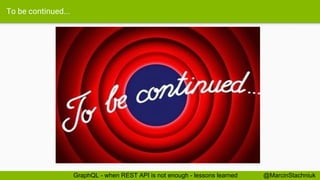




![GraphQL Simple API
GET /customers/2?fields=id,name,email,orders(id,status)
type Customer {
id: ID!
name: String!
email: String!
company: Company
orders: [Order]
}
type Order {
id: ID!
status: Status
}
enum Status {
NEW, CANCELED, DONE
}
{
"data": {
"customer": {
"id": "2",
"name": "name",
"orders": [
{
"id": "55",
"status": "NEW"
},
{
"id": "66",
"status": "DONE"
}
] } } }
{
customer(id: "2") {
id
name
orders {
id
status
}
}
}
RE
ST
@MarcinStachniukGraphQL - when REST API is not enough - lessons learned](https://image.slidesharecdn.com/4devkatographql-whenrestapiistoless-lessonslearned-181106081408/85/GraphQL-when-REST-API-is-to-less-lessons-learned-43-320.jpg)

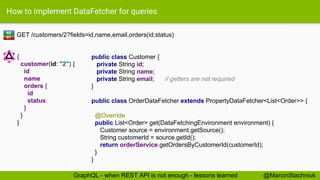







![Code First approach
private GraphQLFieldDefinition customerDefinition() {
return GraphQLFieldDefinition.newFieldDefinition()
.name("customer")
.argument(GraphQLArgument.newArgument()
.name("id")
.type(new GraphQLNonNull(GraphQLString)))
.type(new GraphQLNonNull(GraphQLObjectType.newObject()
.name("Customer")
.field(GraphQLFieldDefinition.newFieldDefinition()
.name("id")
.description("fields with ! are not null")
.type(new GraphQLNonNull(GraphQLID))
.build())
….
.build()))
.dataFetcher(customerFetcher)
.build();
}
Schema First approach
type Query {
customer(id: String!): Customer!
}
type Customer {
#fields with ! are not null
id: ID!
name: String!
email: String!
company: Company
orders: [Order]
}
@MarcinStachniukGraphQL - when REST API is not enough - lessons learned](https://image.slidesharecdn.com/4devkatographql-whenrestapiistoless-lessonslearned-181106081408/85/GraphQL-when-REST-API-is-to-less-lessons-learned-53-320.jpg)

![Schema First approach
type Customer {
# fields with ! are required
id: ID!
name: String!
email: String!
company: Company
orders: [Order]
}
*.graphqls
SchemaParser schemaParser = new SchemaParser();
File file = // ...
TypeDefinitionRegistry registry = schemaParser.parse(file);
SchemaGenerator schemaGenerator = new SchemaGenerator();
RuntimeWiring runtimeWiring = RuntimeWiring.newRuntimeWiring()
.type("Query", builder ->
builder.dataFetcher("customer", customerFetcher))
// ...
.build();
return schemaGenerator.makeExecutableSchema(registry, runtimeWiring);
@MarcinStachniukGraphQL - when REST API is not enough - lessons learned](https://image.slidesharecdn.com/4devkatographql-whenrestapiistoless-lessonslearned-181106081408/85/GraphQL-when-REST-API-is-to-less-lessons-learned-55-320.jpg)





![GraphQL - How to define pagination, filtering, sorting?
Pagination:
● before, after
● offset, limit
Filtering:
● filter(name: “Bob” email: “%@gmail.com”)
● filter: {
OR: [{
email: “%@gmail.com”
}]
}, name: “Bob”
}
Sorting:
● orderBy: ASC, DESC
● sort: NEWEST, IMPORTANCE
@MarcinStachniukGraphQL - when REST API is not enough - lessons learned](https://image.slidesharecdn.com/4devkatographql-whenrestapiistoless-lessonslearned-181106081408/85/GraphQL-when-REST-API-is-to-less-lessons-learned-61-320.jpg)


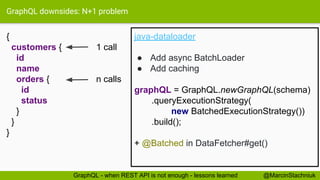

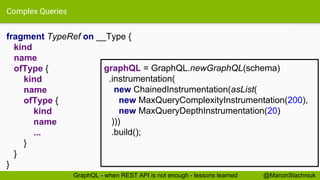







![Testing GraphQL
def "should get customer by id"() {
given:
def query = """{ customer(id: "2") { … } }"""
def expected = [ "customer": [ … ] ]
when:
def result = graphQL.execute(query)
then:
result.data == expected
}
@MarcinStachniukGraphQL - when REST API is not enough - lessons learned](https://image.slidesharecdn.com/4devkatographql-whenrestapiistoless-lessonslearned-181106081408/85/GraphQL-when-REST-API-is-to-less-lessons-learned-74-320.jpg)

